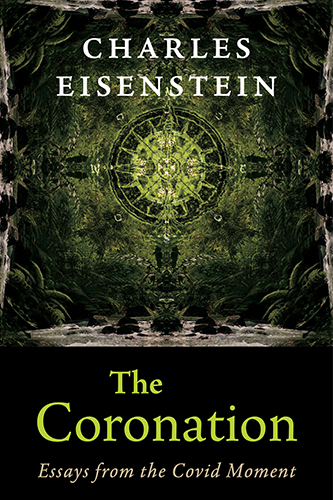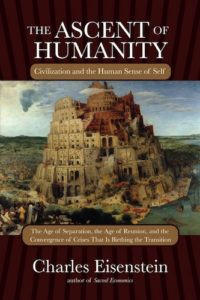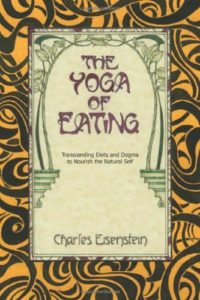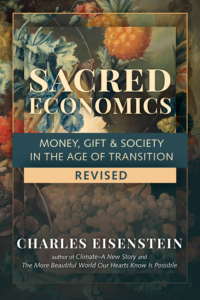The More Beautiful World Our Hearts Know Is Possible
Chapters
Chapter 11: Morphogenesis
Sometimes when I encounter pioneers in a certain domain of alternative culture, I get the feeling that even if they are doing their work on a small scale, perhaps within a small ecovillage, an isolated prison, a single community in a war zone or gang zone, that they are doing that work on behalf of us all, and that the changes they make in themselves create a kind of template that the rest of us can follow, and do in a short time what took them decades of effort and learning. When I see, for example, how my friend R. has, in the face of near-impossible odds, so profoundly healed from being abused as a child, I think, “If she can heal, it means that millions like her can too; and her healing smooths the path for them.”
Sometimes I take it even a step further. One time at a men’s retreat one of the participants showed us burn scars on his penis, the result of cigarette burns administered by a foster parent when he was five years old to punish him. The man was going through a powerful process of release and forgiveness. In a flash, I perceived that his reason for being here on Earth was to receive and heal from this wound, as an act of world-changing service to us all. I said to him, “J., if you accomplish nothing else this lifetime but to heal from this, you will have done the world a great service.” The truth of that was palpable to all present.
The rational mind, steeped in Separation, doubts that his healing could really make a difference. It says, only if it is somehow made public, for example turned into a motivational story, could it have an effect on the world beyond that man’s direct influence. I do not deny the power of story. Maybe J.’s healing is having an influence via my telling of it now. However, story is only one of the possible vectors of manifestation of a more general phenomenon. One of the ways that your project, your personal healing, or your social invention can change the world is through story. But even if no one ever learns of it, even if it is invisible to every human on Earth, it will have no less of an effect.
The principle I am invoking here is called “morphic resonance,” a term coined by the biologist Rupert Sheldrake. It holds as a basic property of nature that forms and patterns are contagious: that once something happens somewhere, it induces the same thing to happen elsewhere. One of his favorite examples is certain substances such as turanose and xylitol, which were reliably liquid for many years until suddenly, around the world, they began to crystallize. Chemists sometimes spend years trying to make crystalline forms of a substance; once they are successful, it is henceforward easy, as if the substance has learned how to do it.
Sheldrake discusses the possibility that this phenomenon could be explained by “seed particles”—little bits of crystal blown by the wind or carried in the beard of a visiting chemist that find their way into a supersaturated solution and initiate crystallization. So, he says, let us test the theory of morphic resonance by quarantining a sample in a dust-filtered lab. If crystals still formed more readily there, he says, it would prove the theory of morphic resonance.
I agree with Sheldrake that certain features of the crystallization mystery defy the seed particle explanation, and that his experiment would disprove it. I disagree, however, that the seed particle explanation, if true, invalidates the morphic field explanation. Quite the opposite: the general principle of morphic resonance pertains whether or not the vector of its transmission is crystal dust. If the quarantine experiment works, one might demand it be electromagnetically shielded as well, since the “seed” could be an electromagnetic vibration. And there may be influences that we don’t even know about. Sheldrake seems to want to separate morphic resonance from any kind of direct causation, but what if all these causal influences are not alternatives to morphic field induction, but rather examples of how that field operates? Here we have the chance to expand the realm of matter to include the properties of spirit, rather than to appeal to something extra-material in order to bestow intelligence on a dead material world.
In a similar vein, it may very well be through others hearing about it that our personal, relational, or local transformations have global significance. It may also be through the ripple effect of changed people changing other people. These are both mechanisms of transmission, of cause and effect, that our Separation-conditioned minds can accept. What we have trouble accepting, though, is that the effect of our actions doesn’t depend on these mechanisms, which are merely means for the implementation of a general metaphysical law. Even if no one ever finds out about your act of compassion, even if the only visible witness is a dying person, the effect is no less than if someone makes a feature documentary about it.
I am not suggesting that we therefore repudiate conventional means for the propagation of our work. I am advocating a kind of confidence in the significance of all that we do, even when our vision cannot penetrate the mysterious, meandering paths through which our actions arrive in the larger world.
There is a kind of senselessness in the most beautiful acts. The acts that change the world most profoundly are the ones that the mind of Separation cannot fathom. Imagine if Kalle Lasn had set out taking care of his mother-in-law with the agenda of making a big public show of his devotion. It would have stank of hypocrisy. The same is true of, say, peacebuilding projects or ecovillages that, too soon, develop a self-conscious image of themselves as an example. Please don’t think that you “have to write a book about it” for your experiences to have a large effect.
The book may come, the peacebuilding project documentary might come, but usually there must first be a latency, a time of doing something for its own sake, a time of inward focus on the goal and not the “meta” goal. The magic comes from that place. From there, the synchronicities flow; there is no sense of forcing, only of participating in a larger happening that seems to have an intelligence of its own. You show up in the right place, at the right time. You respond to practical needs.
Can you believe that changing an old woman’s bedpan can change the world? If you do it to change the world, it will not. If you do it because she needs her bedpan changed, then it can.
Many years ago, Patsy, my wife at the time, was a real estate agent. Her client’s mother, Mrs. K., was terminally ill and lived in a derelict house outside of town. One day Patsy went to the house to take some measurements and found Mrs. K. lying on the floor in her own urine and excrement, unable to get up. Patsy spent an hour cleaning her up and gave her the egg drop soup she’d bought for her own lunch—the only nourishing food Mrs. K. had had for a long time, as the son was working two jobs and living an hour away. Mrs. K. died soon after; a day later the house caved in, as if it had been held together by Mrs. K.’s habits and memories.
At the time, Patsy never imagined that this basic human response to a woman in need would or could change the world. It didn’t cross her mind at all, nor should it have. Her choice to help was a choice between compassion and the practical demands of her busy schedule. Part of her mind was chattering, “Just call the police, you’re going to miss your other appointments, this isn’t your responsibility, what does it matter …” But on some level she knew that it did matter. So many voices lobby us to forget love, forget humanity, sacrifice the present and the real for the sake of what seems more practical. Herein lies the medicine of despair: by evacuating our illusions of practicality, it reconnects us to the present needs at hand and allows those senseless, impractical acts that generate miracles.
The principle of morphic resonance justifies our feeling that these senseless, invisible acts are somehow significant. What morphic field does it induce, to trust the promptings of compassion? What morphic field does it induce, to give as best you can of your gifts to meet the needs at hand? Imagine if our politicians and corporate executives were caught up in this field, acting from compassion rather than calculation, from humanity rather than abstract instrumental motives.
No doubt some of you are thinking, “Eisenstein seems to think that if everyone just focuses on taking care of their grandmother and picking up litter in the park, that global warming, imperialism, racism, and the rest of the catastrophic problems facing our planet will magically fix themselves. He fosters a dangerous passivity, a complacency that leaves people imagining they are doing something useful, while the world burns.” The last few chapters should make it clear that that is not what Eisenstein thinks, but just to be sure, let me address this criticism head-on; after all, I have heard it not only from others but also, with much greater frequency, in my own head.
First, the personal, local, or invisible actions I have been discussing do not preclude other kinds of actions such as writing a book or organizing a boycott. In fact, listening to the call and trusting the timing of the former foster the same disposition toward the latter. I am talking about a wholesale movement into a place of interbeing, and acting from that place in each kind of situation. The universe calls forth different of our gifts at different moments. When the call is for the small and personal, let us heed that, so that we develop the habit of heeding it when it is big and public. Let’s cease listening to the logic of Separation, which would devalue the small and personal.
Just as the vectors of morphic resonance may be something quite mundane, so also the actions for creating the impossible might each, on their own, be quite linear and practical. It is their orchestration that is beyond our capacity. Many of us, pressed on by the urgency of the planetary situation, have experienced trying to do big things that amounted to nothing. We write a book and no one publishes it. We shout the truth from our blogs and no one gets it, except the already-converted. Except sometimes it is different. When, and why?
When my elder two children were young I was for several years a stay-at-home dad, immersed in a world of diapers and groceries while trying to write my first book. I often felt terribly frustrated, torturing myself with thoughts like “I have such important things to share with the world, and here I am changing diapers and cooking all day.” These thoughts distracted me from the gift at hand and made me less present with my children. I did not understand that those moments when I gave in to my situation, put down my writing, and fully engaged my children had just as powerful an effect on the universe as any book I would write. We don’t always have the eyes to see it, but everything has its karmic effect, or as the Western religions say, God sees everything.
Imagine yourself on your deathbed, looking back on your life. What moments will seem the most precious? What choices will you be the most grateful for? For Patsy it will be cleaning up Mrs. K., more than any real estate she sold. For me it will be pushing Jimi and Matthew up the hill in their toy cars, more than any public accomplishment I have recorded. On my deathbed I will be grateful for each choice of connection, love, and service.
Can you countenance a universe in which those deathbed perceptions are wrong? Can you countenance a universe in which we must steel ourselves to neglect those things so that we can more efficiently devote ourselves to the business of planet-saving?
Can you see that steeling ourselves to override our humanity is what has gotten us into this mess to begin with?
That is the old story. We are nearly done with conquering ourselves, just as we are nearly done trying to conquer nature. Thankfully, our entry into the world of interbeing no longer need oppose what science tells us about the nature of reality. We can begin to embrace new scientific paradigms that affirm the understanding that the universe is intelligent, purposive, and whole. These new paradigms arouse the ire of the old guard precisely because they affirm such an understanding. That is why they are called “unscientific” or “pseudoscientific”—not because they draw on inferior evidence or incoherent thinking, but because they violate the deep, unquestioned premises that the word “scientific” has encoded.
Let’s get real here. If everything has consciousness, then what we had believed possible, practical, and realistic is far too limiting. We are on the cusp of an epochal breakthrough, coming into touch with the mind of nature. What can we achieve when we are in harmony with it? I mean “get real” as the opposite of its usual meaning, which would be to ignore the unmeasurable and the subjective in favor of what can be quantified and controlled. That mentality has put vast human capacities out of reach: the technologies of reunion that include much of what we call “alternative” or “holistic” today. All draw in one way or another from the principle of interbeing.
The contradiction between small, personal acts of compassion and steps to save the environment is a straw man, a contrapositive rhetorical device constructed by the cynic to voice his wound of powerlessness. In truth, the habit of acting from love will naturally apply to all our relationships, expanding alongside our understanding. Acts of ecological or social healing, so long as they are in earnest and not secretly designed to establish an identity or prove oneself good, are just as senseless as the small, personal ones. They are senseless because they are a drop in the bucket. What can one person do? As I have said, despair is inescapable in the old story. The alternative, an interconnected, intelligent universe, empowers those acts, but at a price for the activist—it equally empowers the small-scale acts that don’t fit into her save-the-world paradigm at all. It makes her climate change awareness campaign no more and no less important than changing the bedpans in the hospice. But again, would you really like to live in any other world?
***
A friend recently asked me, “If it is true that we live at a unique juncture in the planet’s history, when all great beings have gathered for the crucial moment of humanity’s birthing, then why do we not see the great avatars and miracle-workers of yesteryear?” My answer was that they are here, but they are working behind the scenes. One of them might be a nurse, a garbage man, a kindergarten teacher. They don’t do anything big or public, nothing that, through our eyes, looks like it is generating the miracles necessary to save our world. Our eyes deceive us. These people are holding the fabric of the world together. They are holding the space for the rest of us to step into. To do the big, public things is important, requiring all our gifts of courage and genius, but it requires not nearly the faith and solidity in the ground of interbeing as the invisible, humble actions of people like those kindergarten teachers.
So, whatever your reasons for choosing to do great things or small, do not let them be the urgent, fearful belief that only the big, public things have any chance of influencing the masses and saving the world. As I will describe later in the book, part of the revolution in which we are participating is a revolution in how we make our choices. To do the possible, the old way works fine. When we have a map from A to B, we can just follow the directions. Now is not that time. The calculable results are not enough. We need miracles. We have caught a glimpse of our destination, the destination that hope foretells, but we have no idea how to get there. We walk an invisible path with no map and cannot see where any turning will lead.
I wish I could say that the new story provides a map, but it does not. It can, however, remove the disorienting fog of habits and beliefs, leftovers of the old paradigms, that obscure our internal guidance system. The principles of interbeing do not, on their own, offer a formula for decision making. Even if you accept that “I and the world are one,” you will not be able to distinguish whether it will benefit all sentient beings more to stay home and reduce your carbon emissions, or to drive to the rally to protest fracking. To attempt such a calculation draws from the old story, which seeks to quantify everything, to add up the effects of any action, and to make choices accordingly. That way of making choices is useful only in certain, narrow circumstances—in particular, those in which cause and effect are more or less linear. It is appropriate for many engineering problems and financial decisions. It is the mindset of the actuary, weighing risks and payoffs. The new story is a much bigger change than to revalue the risks and seek new payoffs. It is not going to help you make choices from the calculating mind. But it will provide a logical framework within which our heart-based choices make a lot more sense.
Endnote:
9. These premises also determine what is publishable and what isn’t, what will pass peer review easily and what will be subjected to hostile scrutiny, and what research will receive funding and what will not. These are some of the reasons why certain real phenomena remain “scientifically unproven.”






